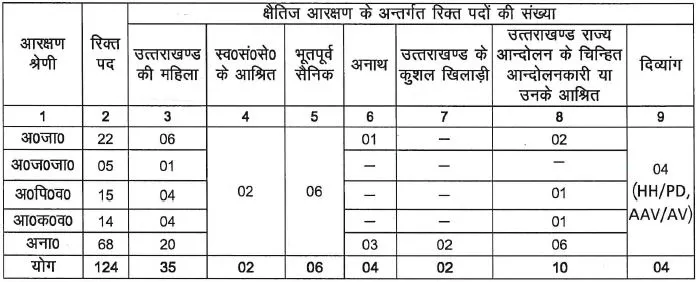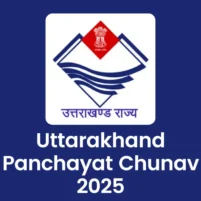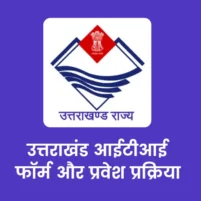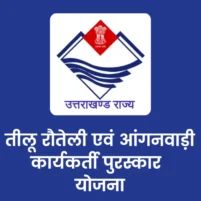UKSSSC Van Daroga Answer Key 2025 for the written exam successfully conducted on 22nd June at 151 centres across the state is now available to download in pdf. As per reports, out of around 54800 registered candidates, around 38200 candidates appeared in the exam. You can download Uttarakhand Van Daroga (Forester) Answer Key 2025 (released on 26th June) for all sets (A, B, C, D) and submit objections online using the links below. Stay connected for latest updates about UKSSSC Van Daroga Result 2025.
Van Daroga Answer Key 2025
Submit Online Objections
UKSSSC Van Daroga Admit Card 2025: The written exam date has been fixed which will now be conducted on 22nd June 2025 (11 AM to 01 PM) in a single shift across the state. Earlier this exam was scheduled on 29th June but due to UKPSC Upper PCS Pre on the same day, now it is being conducted on 22nd June instead of 29th June. You can download Van Daroga (Forester) Admit Card from 16th June 2025 through direct link given below (updated).
Admit Card Download: From 16th June 2025
Exam Date (New): 22nd June 2025 (11 AM to 01 PM)
UKSSSC Van Daroga Admit Card 2025 are now available to download which you can download through the direct link given below by using Email and Password or Application Number and Date of Birth or Name, Father’s Name and Date of Birth.
Van Daroga Exam Date Notice
Download Van Daroga Admit Card
UKSSSC has invited applications for filling up the following 124 Vacancies of Van Daroga (Forester) in Uttarakhand Forest Department by direct recruitment. All eligible male and female candidates can apply online for the Van Daroga/ Forester Bharti Vacancies through sssc.uk.gov.in from 06th Feb to 28th Feb 2025. UKSSSC Van Daroga Recruitment, Physical & Exam Syllabus 2025 as online application form, vacancy details, salary, qualification, selection process, admit card etc info is given below.
Uttarakhand Van Daroga (Forester) Recruitment 2025
उत्तराखण्ड अधीनस्थ सेवा चयन आयोग द्वारा समूह ‘ग’ के अन्तर्गत वन विभाग में वन दरोगा (Forester) के कुल 124 रिक्त पदों पर सीधी भर्ती परीक्षा से चयन हेतु दिनांक 06 फरवरी से 28 फरवरी 2025 तक योग्य एवं इच्छुक अभ्यर्थियों से ऑनलाइन आवेदन पत्र आमन्त्रित किए गए हैं।
Post Name and Nature – वन दरोगा (Forester) (अराजपत्रित/ स्थायी/ अंशदायी पेंशनयुक्त)।
Pay Scale – Rs 29200-92300 (Pay level 05).
Post Code – 679/ 724/ 68/ 2025
Total Number of Vacancies – 124 Posts (Group C)
UR Category – 68 Vacancies
EWS Category – 14 Vacancies
OBC Category – 15 Vacancies
SC Category – 22 Vacancies
ST Category – 05 Vacancies
See also: Uttarakhand Samuh G Recruitment Group C Posts 2025-2026
See the image below for the category wise Uttarakhand Van Daroga (Forester) vacancy details.

Eligibility Criteria (Age and Qualification):
Age Limit – 18 to 28 years as on 01st Jul 2025 (relaxation in upper age limit is applicable as per Govt rules). Due to the special working nature of the post, the maximum age limit has been kept at 28 years.
Educational Qualification – 12th Pass (Intermediate) with Science or Agriculture from a recognized Board or equivalent qualification.
In order to apply for direct recruitment of Group C Posts, the candidate must be registered in any employment office located in Uttarakhand till the last date of receipt of application, OR the candidate should be a holder of Domicile/ Permanent Residence Certificate of Uttarakhand, OR the candidate must have passed his/her 10th or 12th or equivalent level education from recognized institutions located in Uttarakhand.
See also: Uttarakhand Forest Guard Recruitment 2025
Selection Process, Physical and Exam Pattern
The selection process for Uttarakhand Van Daroga post will be completed in 02 phases. In the first phase, there will be a written exam (OMR based) conducted and then candidates selected on the basis of written exam merit will be called for physical tests (qualifying in nature).
UKSSSC Forester (Van Daroga) selection process consists of Written Examination (OMR Based), Physical Standards Test and Physical Efficiency Test as per the pattern given below.
Written Examination
Uttarakhand Van Daroga written exam will be of maximum 100 Marks. The question paper will be of 02 Hours duration and will consist of total 100 Objective Type Multiple Choice questions (01 Mark each) based on Science and Agriculture (up to 12th standard). There will be negative marking of 0.25 marks for every wrong answer given by candidates. Minimum 45 marks for GEN/ OBC and 35 marks for SC/ST are required to qualify in the written exam.
The latest and detailed UKSSSC Van Daroga Syllabus is given below. Check the given link for Written Exam Syllabus and Pattern for all other Group C posts.
See also: Uttarakhand Samuh G Syllabus Group C Exam 2025-2026
After the OMR Based Written Examination, candidates (02 times the number of vacancies) selected on the basis of exam merit will be called to appear for Physical Standards Test and Physical Efficiency Test (qualifying in nature) consisting the events given below.
Physical Standards Test
Male Candidates:
Height – Minimum 163 Cms (152 Cms in case of the Scheduled Tribes and candidates belonging to the Gorkha, Nepali, Assamese, Ladakhi, Sikkimese, Bhutanese, Garhwali, Kumaoni, Naga etc).
Chest – 05 Cms expansion.
Female Candidates:
Height – Minimum 150 Cms (145 Cms in case of the Scheduled Tribes and candidates belonging to the Gorkha, Nepali, Assamese, Ladakhi, Sikkimese, Bhutanese, Garhwali, Kumaoni, Naga etc).
Chest – 05 Cms expansion.
Physical Efficiency Test
Male Candidates – 25 Kms Run in maximum 04 Hours.
Female Candidates – 14 Kms Run in maximum 04 Hours.
For selection as Van Daroga (Forester), final merit list will be prepared on the basis of marks obtained in the OMR Based Written Examination. In the case of obtaining similar marks by two or more candidates, the merit will be determined on the basis of higher age.
See also: UKSSSC पटवारी/ लेखपाल भर्ती, Syllabus & Physical (180 Posts)
UKSSSC Van Daroga (Forester) Syllabus
The latest and detailed Syllabus of Uttarakhand Van Daroga (Forester) Exam 2025 for Physics, Chemistry, Biology, Environment, Agriculture and Mathematics subjects provided by UKSSSC is as follows:
Unit-1 (Physics)
Motion: Distance and displacement, Speed and Velocity. Non-uniform and uniform motion, Acceleration, Equations of motion, Elementary idea of uniform circular motion. Force and motion, Newton’s laws of motion, Inertia of a body, Mass as a measure of inertia, Elementary idea of conservation of momentum.
Gravitation: Gravitation, Universal law of gravitation, Gravity, Acceleration due to gravity, Mass and weight, free fall.
Floatation: Thrust, Pressure, Archimedes principle, Buoyancy, Relative density.
Work, Energy and Power: Work done by a force, Energy, Power, Kinetic and potential energy, Law of conservation of energy.
Electricity and Magnetism: Charge, Potential difference, Electric current, Ohm’s law, Resistance, Combination of resistances (equivalent resistance), Factors affecting resistance, Heating effect of current, Electric power, Inter-relations among P, V, I, and R.
Magnetic field, Field lines, Field due to a current carrying wire, coil and solenoid, Force on current carrying conductor, Fleming’s left-hand rule, Electro-magnetic induction, Induced potential differential, Induced current, Fleming’s right-hand rule, DC & AC, Advantages of AC over DC.
Heat: Heat, Measurement of temperature, Scales of temperature, Units of heat, Specific heat, Heat capacity, Effect of high heat capacity of water in daily life, Principle of calorimetry, Specific heat of soil, Physical changes in soil due to heat, Newton’s law of cooling, Transmission of heat: conduction, convection and radiation. Common applications of heat conduction and heat convection.
Light: Reflection of light at plane and curved surfaces, Image formed by spherical mirrors, centre of curvature, Principal axis, Principal focus, Focal length, Mirror formula (no derivation). Refraction of light, Refractive index, Refraction by lens, Image formation by lens, Lens formula (no derivation), Magnification, Power of lens, Human eye, Refraction of light through prism, Scattering of light, Daily life examples of these effects. Rainbow, Applications of spherical mirrors and lenses.
Sound: Nature of sound, Propagation of sound in various media, Speed of sound, Range of human hearing, Ultra-sound, Reflection of sound, Echo and SONAR.
Atmosphere: Atmosphere and its composition, Atmospheric stratification, Atmospheric pressure, Simple barometer, Standard atmospheric pressure, Effect/consequences of atmospheric pressure, Dew point, Absolute humidity, Relative humidity, Condensation of water vapour in atmosphere, Different forms of clouds, Greenhouse effect, Basics of weather forecasting.
Unit-2 (Chemistry)
Matter and its properties: Definition and classification of matter. Solid, liquid and gas: characteristics- shape, volume, density; change of state- melting, freezing, evaporation and factors affecting evaporation, condensation, sublimation. Solution, colloids and suspension. Mixtures: heterogenous and homogenous mixtures, separating the components of a mixture.
Particle nature and basic units: Atoms, molecules. Law of chemical combination. Law of conservation of mass. Law of constant properties. Atomic mass, molecular mass, formula unit mass, mole concept, relationship of mole to mass of the particles and number. Chemical formula of common compounds.
Structure of atom: Electrons, Protons and neutron. Thomson atomic model, Rutherford’s atomic model. Electronic configuration. Isotopes and Isobars.
Acids, bases and salts: Definitions, properties and applications. Concept of pH scale, importance of PH in everyday life. Preparation and uses; Sodium hydroxide, Bleaching powder, Baking soda, Washing soda and Plaster of paris. Reaction of acid and bases with metals. Reactions of metal carbonates and metal hydrogen carbonates with acids. Reaction of metallic oxides with acids. Reaction of non-metallic oxides with base. Strength of acids and bases.
Chemical reactions: Chemical equations. Types of chemical reactions: combination, decomposition, displacement, double displacement, precipitation, neutralisation, oxidation and reduction. Rancidity.
Metals and non-metals: Properties of metals and non-metals. Reactivity series. Formation and properties of ionic compounds. Occurrences and extraction of metals. Metallurgical processes. Enrichment of ores. Refining of metals. Corrosion and its prevention.
Carbon compounds: Covalent bonding in carbon compounds. Versatile nature of carbon. Nomenclature of carbon compounds. Functional groups. Saturated and unsaturated hydrocarbons. Chemical properties of carbon: combustion, oxidation, addition reaction and substitution. Properties and uses of Ethanol and Ethanoic acid.
Periodic classification of elements: Modern periodic table. Gradation in properties.
See also: उत्तराखंड VDO/ VPDO भर्ती and Exam Syllabus (221 Vacancies)
Unit-3 (Biology)
Life Processes: Living things; Basic concept of nutrition, photosynthesis, respiration, transport and excretion in plant and animals.
Biological diversity: Diversity of plants and animals, International rules of nomenclature, Salient features and classification of plants (Bacteria, Thalophyta, Bryophyta, Pteridophyta, Gymnosperms and Angiosperms). Salient features and classification of animals (Non chordates up to phyla and chordates up to classes).
Cell: Prokaryotic and eukaryotic cells. Structures and functions of various organelles like plasma membrane, cell wall, chloroplast, mitochondria, endoplasmic reticulum, golgi appartus, nucleus and chromosomes. Cell division. Nucleic acids (DNA and RNA): DNA replication, transcription and translation. Origin of life and basic concept of evolution. Mendel’s law of inheritance, linkage, crossing over, sex determination and sex linked inheritance. Mutation.
Tissues: Tissue system, important plant and animal tissues.
Control and co-ordination in animals and plants: Neural and Hormonal control in animals.
Reproduction: Reproduction in plants and animals (Asexual and sexual). Methods of family planning. Sexually transmitted diseases, HIV/AIDS.
Human Health and diseases: Infectious and Non-infectious diseases. Diseases caused by microbes (Virus, bacteria, fungi and protozoa).
Unit-4 (Environment)
Natural resources and their conservation: Renewal and Non-renewal resources. Big dams, Sources of energy (Fossil fuels, solar energy, wind, water and tidal energy. Nuclear energy. Biogas.
Biodiversity: Definition and hot spots of biodiversity.
Ecology and Environment: Ecosystem. Important ecosystem types with special emphasis on forest ecosystem. Major abiotic and biotic component. Nutrient Cycling, Hydrological cycle. Trophic levels, food web, Ecological pyramids and energy flow. Soils of different ecosystem. Soil Erosion and preveiitive measures. Environmental pollution and pollutants. Biodegradable and non-biodegradable substances. Ozone depletion. Environmental legislations including forest policy legislation.
Wildlife: Conservation and uses. Scientific and common name of common wildlife (reptiles, birds and mammals) with special reference to Uttarakhand. Ex-situ 1 pa-situ_gomnservation. Protected areas, (Sanctuary, National parks and Biosphere Reserves). Project tiger, and Musk deer project, Ramsar sites. Red Data Book.
Forestry: Forests in Uttarakhand, Temperate and sub temperate forests. Important forest resources of Uttarakhand. Important timber plants and minor forest products. Forest mensuration, pathology and entomology. Forest management and people participation. Water harvesting and check dams. Social forestry.
Unit-5 (Agriculture)
Agriculture, agroforestry and silviculture: Definition and scope.
Classification and uses of fertilizers and manures. Irrigation and drainage. Organic farming- concept, principles and certification.
Seed: Classification, structure and types of seed. Seed germination and its types. Germination in some common seeds (Pea, Bean and Maize). Seed dormancy.
Crop Production: Soil, climatic requirement, importance and classification of major crops (Rice, Wheat, Maize, Chickpea, Lentil, Potato, Tomato, Sugarcane and common millets grown in Uttarakhand). Major diseases in crops causes by microbes (bacteria, fungi and virus) and their prevention.
Mineral nutrition in plants: Macronutrients and micronutrients. Deficiency and toxicity symptoms of essential nutrients. Carbon and nitrogen cycle. Nitrogen fixation.
Plant growth regulators: Auxins, gibberellins, cytokinin, abscisic acid and ethylene. Photoperiodism and vernalisation.
Basic statistical analysis: Mean, median and mode.
Livestock: Animal husbandry, poultry, piggery, apiculture, sericulture and fishery.
Unit-6 (Mathematics)
Number system: Real numbers, rational and irrational numbers; operations on real numbers, nth roots of real number, rationalization: Indices and logarithms.
Algebra: Polynomials, factors and multiples, zeros of a polynomial, remainder theorem, factorization of quadratic and cubic polynomials. Linear equations in one and two variables. Arithmetic progression.
Coordinate geometry: Graphical solution of linear equations, distance formula, section formulae, straight lines.
Geometry: Congruency in triangles, similarity in triangles, basic proportionality theorem, quadrilaterals, circles (angle properties, cyclic properties, tangent and secant properties), locus.
Mensuration: Area and perimeter of plane figures, surface area and volume of cube, cuboid, sphere, cylinder and cone.
Trigonometry: Trigonometric ratios of an acute angle in a right angle triangle, trigonometric identities, problems on height and distance.
Statistics: Graphical representation of statistical data, measures of central tendency (mean, median, mode). Probability.
See also: UKSSSC कनिष्ठ सहायक भर्ती and Exam Syllabus (465 Vacancies)
Application Form, Important Dates and Notification
Before filling online application, you will have to go through the UKSSSC OTR (One Time Registration) process to apply for any group c recruitment. Keep ready educational details and scanned images of photograph (Max 50 kb), signature (Max 20 kb) and thumb impression (Max 50 kb) in JPG format for OTR.
After the successful registration, you can submit online application form for the UKSSSC Uttarakhand Van Daroga Recruitment through the website sssc.uk.gov.in from 06th Feb to 28th Feb 2025.
You are advised to read the official recruitment notification carefully and follow all the instructions given for submission of online application form.
Examination fee:
UR/ OBC Category – Rs 300/-
SC/ ST/ EWS/ PH Category – Rs 150/-
ORPHAN Category – Nil
The requisite fee can be paid online by using Net Banking/ Debit Card/ Credit Card/ UPI.
Important Dates:
Commencement of filling of online application – 06th Feb 2025
Last date for filling of online application – 28th Feb 2025
Last date for payment of application fee – 28th Feb 2025
Written exam date (निर्धारित) – 22nd June 2025 (See UKSSSC Exam Calendar)
Exam Date and Admit Card – UKSSSC Van Daroga written exam is now scheduled to be held on 22nd June 2025 (Confirmed). Admit Cards will not be sent by Post, rather it will be available online to download through the official website. Stay connected for Van Daroga exam date, admit card, physical and related latest news updates.
Register and submit the online application form by visiting at the direct link provided below (available from 06th Feb 2025). For more details about the UKSSSC Uttarakhand Van Daroga Recruitment, you can download official Notification (Vigyapti) 68/UKSSSC/2025 in pdf format.
See also: Uttarakhand 120 Pashudhan Prasar Adhikari Recruitment
See also: UKPSC Forest Range Officer, Logging, Asst Recruitment
Search any information available on this site by the help of the search box above. You may visit later for other latest updates related to Uttarakhand Van Daroga Recruitment, Forester Vacancy, Van Vibhag Bharti etc.




Van Daroga
sir mai polytechnic vala hun, please btaiye kya mai ise bhr skta hun ???
sir mera van daroga ka application form no miss ho gaya he muje no mil sakta he
You can recover it through the recruitment portal.
exam april me hi hoga Naa??
There is no confirmation yet.
Dear sir mara exam bareis ka karan road block hona ka karan cut gaya ha
Sir van daroga physical test 2022 kab hoga ??
sir van doroga exam kb tk hoga please suggest Date..
The re-exam is likely to be held in Mar-Apr, stay connected for related latest updates.
thanks sir
Sir jo bacche exam nhi de paye the…. iss baar wo bhi exam de skte h kya
Yes
Sir ab forester ka form kab ayega 2023 ke baad ….?
sir namaskar
main Ganga Hara ki nivasi hun.